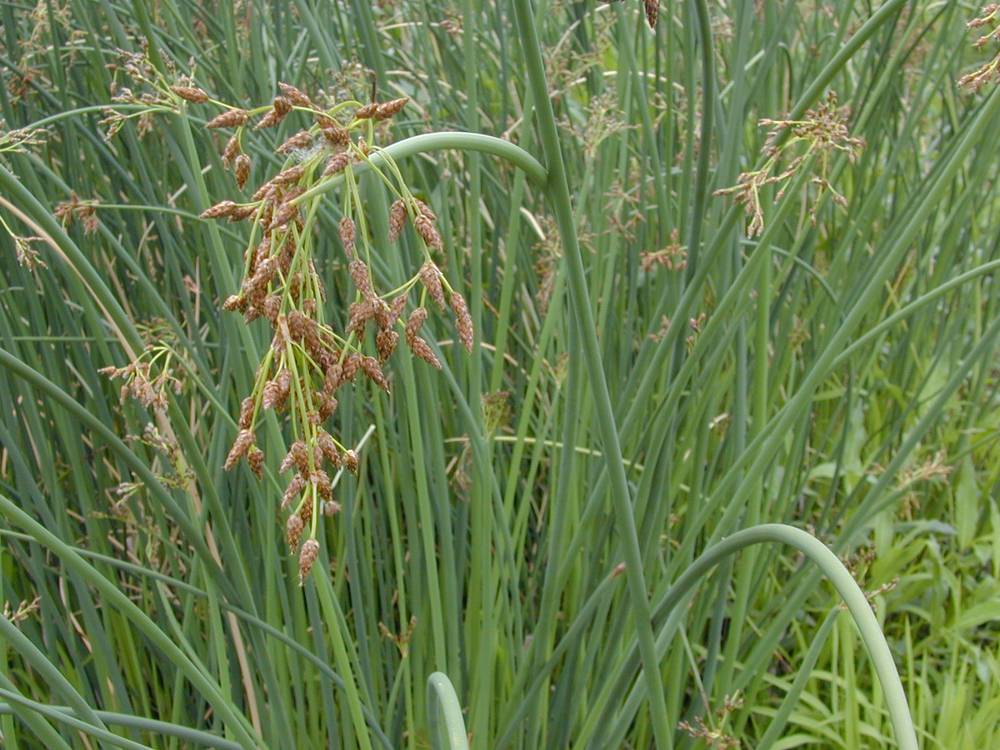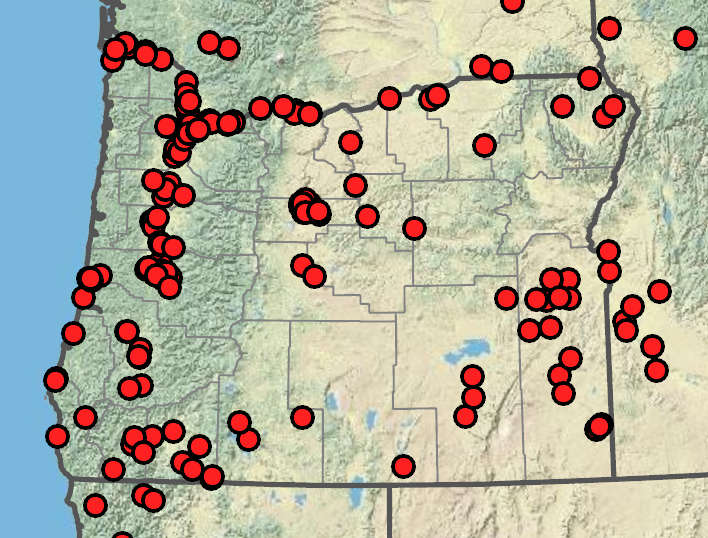Schoenoplectus tabernaemontani
Cyperaceae
soft-stem bulrush, tule
sedge family
3–10 mm thick.
cylindric, 50–300 cm × 2–10 mm.
usually triangular, occasionally terete, rarely compressed or quadrangular; solid or pithy.
basal and/or cauline, alternate, usually 3-ranked, bases forming cylindric sheaths enclosing stem;
margins fused;
ligules often present;
blades frequently absent from some basal leaves, rarely from cauline leaves; when present flat, folded, rolled, or terete, linear.
C-shaped to dorsiventrally flat in cross section, usually much shorter than sheath;
distal blade 2–200 × 1–4 mm;
margins often scabridulous.
proximal bract usually erect, thickly C-shaped to subterete, 1–8 cm.
15–200; solitary or less often in clusters of 2–4(7); clusters on branches to 15(25) cm long;
spikes 3–17 × 2.5–4 mm; floral scales ovate, 2–3.5 × 1.5–2 mm, uniformly dark to pale orange-brown, sometimes straw-colored, sometimes with prominent linear dots;
midrib often pale or green, sparsely (rarely densely) reddish or straw-colored scabrous on awn and distal parts of midrib and sometimes flanks;
margins ciliate;
hairs contorted;
apex obtuse to rounded; notch 0.2–0.3 mm deep; awn straight or bent, 0.2–0.8 mm.
with a shortened axis; floral scales 1–many, crowded, spirally arranged, sometimes 2-ranked, usually each subtending a single flower or perigynium, sometimes proximal and/or distal scales empty; perigynia if present closed or open down one side, subtending and enclosing a very short rachilla-bearing 1-pistillate flower (Carex), sometimes also (0)3 staminate flowers and empty scales (Kobresia);
spikes aggregated into secondary inflorescences that are panicles, often modified and sometimes consisting of a single spike; secondary inflorescences usually subtended by a foliaceous or scale-like or bristle-like bract.
perianth bristles 6; more or less equaling achene, densely retrorsely spinulose, brown;
stigmas 2, sometimes 3 near spike apex.
bisexual (unisexual in Carex and Kobresia);
perianth absent or consisting of (1)3–6(30) bristles and/or scales;
stamens usually (1)3, rarely more;
ovary with 1–3(4) carpels, fused; locule 1;
style undivided or branched;
stigmas 2–3(4).
achenes, usually trigonous or biconvex.
plano-convex, 1.5–2.8 × 1.2–1.7 mm;
beak 0.2–0.4 mm.
=42.
Schoenoplectus tabernaemontani
Cyperaceae
Freshwater to brackish marshes, bogs, lakes, stream banks, and disturbed wetlands, often emergent in shallow water. 0–1600 m. Throughout Oregon. CA, ID, NV, WA; throughout North America; southern South America; Africa, Australia, Eurasia, New Zealand, Pacific Islands. Native.
Schoenoplectus tabernaemontani is a cosmopolitan, variable taxon. North American populations have sometimes been treated as S. validus. Schoenoplectus acutus, also common in Oregon, is very similar. Schoenoplectus tabernaemontani hybridizes with S. acutus, S. californicus S. glaucus, S. heterochaetus, and S. triqueter. Hybrids tend to be fertile. Yellow-striped forms of S. tabernaemontani are cultivated as ornamentals.
Cosmopolitan. Approximately 100 genera; 16 genera treated in Flora.
Cyperaceae (except Eleocharis) is characterized by unusual holocentric chromosomes, in which spindle fibers attach throughout the length of the chromosome, not at discrete centromeres. Also, reduction of chromosome number occurs at the second division of meiosis. These traits are shared with the related family Juncaceae but not by other vascular plants. Chromosome numbers in sedges are often very high, but it is unclear if this represents polyploidy or fragmentation of holocentric chromosomes. When collecting sedges, get the rhizomes (if present) because some species are distinguished by their cespitose or rhizomatous growth form. If possible, collect extra inflorescences because checking floral traits can be destructive. In some genera, species identification requires mature fruits.
Barbara Wilson, Richard Brainerd, Nick Otting
- Local floras:
BC,
CA,
OR,
WA
- Local Web sites:
CalFlora,
CalPhotos,
Flora NW,
PNW Herbaria
WildflowerSearch
iNaturalist (observations)
USDA Plants Database
- LBJ Wildflower Center
- SEINet
- Plants of the World Online
- Encyclopedia of Life
- Wikipedia
- Google Image Search
- Local floras:
CA,
OR
- Local Web sites:
CalFlora,
CalPhotos,
Flora NW,
PNW Herbaria
WildflowerSearch
iNaturalist (observations)
- LBJ Wildflower Center
- SEINet
- Plants of the World Online
- Encyclopedia of Life
- Wikipedia
- Google Image Search



